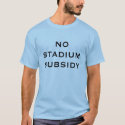
According to Yahoo! Weather, the forecast for Tuesday evening in Santa Clara is "a few clouds. Low 49F. Winds NW at 10 to 20 mph."
Sounds like a perfect evening for . . . ?
Well, if you're a Santa Clara resident, it sounds like a perfect evening for attending your City Council's meeting. It should be nice and warm in the Council Chambers, and while you'll be protected from the cool winds, there is certain to be plenty of bluster inside.
The fun starts at 7:00 P.M. at City Hall in the Council Chambers, 1500 Warburton Avenue, Santa Clara, 95050.
The hot topic for the evening will probably be Keyser Marston Associates' evaluation of the 49er/CS&L Economic and Fiscal Benefits Study — what did we get for our $75,000?
You can read the report yourself — click the "Report" link after item 5C on the City Council's agenda for June 5.
With some notable exceptions (like the fact that using the same land for an office building would generate almost 5 times the revenue to the City with little or no public subsidy), the report generally confirms the 49ers' numbers, while offering similarly limited evidence that would help to evaluate the claims.
Also like the 49ers' report, it fails to consider the three important issues economist Brad Humphreys has identified as weaknesses in most economic impact studies (and which we discussed here last week): gross spending vs. net spending, concentrated benefits but diffuse costs, and forecast uncertainty.
From my point of view, this forecast raises more questions than it answers.
Here's a few random ones I have:
- How much interest will we pay on $180+ million in debt?
- What fraction of this interest will be covered by the estimated $700,000 in direct General Fund Revenue generated by a stadium?
- After subtracting interest costs, will the city get anything close to a reasonable return on this "investment"?
- That $700,000 assumes that the Stadium Authority will reimburse the city for "all municipal costs associated with the stadium's on-going operations." Which, of course, also assumes that the Stadium Authority will have the money to make these payments. How reasonable is that assumption?
- If we're being asked to partner with the San Francisco 49ers in building this stadium, can we find out how much money THEY expect to make from it? What do THEIR revenue streams look like?

2 comments:
One of the major problems with the Keyser-Marston analysis is that they used CS&L's (the 49ers consultant) data and surveys. KM did not acquire their own data on the economics of the stadium but said that most of the CS&L data was reasonable.
KM's assertion, though, in its addendum that an office building on the proposed stadium location would generate significantly more money is a nice rebuke to the self-serving conclusions of the CS&L report.
For those interested in the quality of sports franchise-financed studies, it is worthwhile to read "Professional Sports Facilities, Franchises, and Urban Economic Development" by University of Maryland economics profs Dennise Coates and Brad Humphreys. (I have excerpts from and a link to it on my www.blueroom.com/nostadiumarticles.htm page.) A core excerpt: "Every time the owner of a professional sports franchise wants a new facility built using public financing, an 'economic impact study' is commissioned to justify the spending of hundreds of millions of dollars of public money on the projects. These impact studies are always prospective in nature – they forecast the future economic impact flowing from a new publicly financed sports facility – and always conclude that there will be large positive economic benefits to the local economy."
Sound familiar?
- John Hogle
Tuesday night, the local 49ers booster club repeated their old saw:
"If I had $160 million, boy, wouldn't I give it to the 49ers. Where else can I make all that money?"
Okay, that's nice. But they don't have $160 million lying around. Nor does Santa Clara. So, we'd have to borrow that money.
According to www.mortgage-calc.com, a 30 year mortgage for $160M at 5% interest would cost the city $859,000 per month. That's $10,308,000 per year. Economic benefit to the city is about $700,000 per year.
Hey, maybe the booster club could pitch in the extra $9,608,000 a year!
Post a Comment